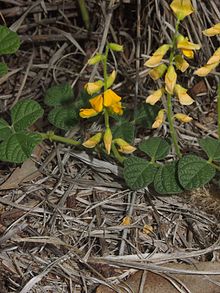
Lablab purpureus is a species of bean in the family Fabaceae. It is native to sub-Saharan Africa and India and it is cultivated throughout the tropics for food. English language common names include hyacinth bean, lablab-beanbonavist bean/pea, dolichos bean, seim or sem bean, lablab bean, Egyptian kidney bean, Indian bean, bataw and Australian pea. Lablab is a monotypic genus.

Euonymus europaeus, the spindle, European spindle, or common spindle, is a species of flowering plant in the family Celastraceae, native to much of Europe, where it inhabits the edges of forest, hedges and gentle slopes, tending to thrive on nutrient-rich, chalky and salt-poor soils. It is a deciduous shrub or small tree.
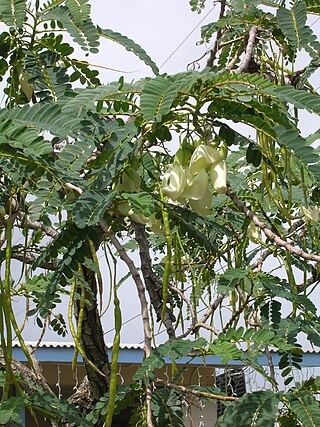
Sesbania grandiflora, common names vegetable hummingbird, katurai, agati, and West Indian pea, is a leguminous tree of family Fabaceae native to Maritime Southeast Asia and Northern Australia. The flowers are eaten in Southeast and South Asia.

Dioscorea trifida is a species of flowering plant in the family Dioscoreaceae. It is a species of yam. It is native to the Caribbean and Central and South America. Its many common names include Indian yam, cush-cush, and yampee. It is called mapuey in Venezuela, inhame in Brazil, tabena and ñame in Colombia, sacha papa in Peru, and ñampi in Costa Rica.

Rhynchosia, also known as snoutbean, is a genus of plants in the family Fabaceae. It includes 260 species of herbs, vines, and subshrubs native to tropical, subtropical, and warm temperate regions around the world, ranging from the southern United States to northern Argentina in the Americas, and through Africa, the Arabian Peninsula, southern Asia from Iran to Korea and Japan, New Guinea, and Australia. Typical habitats include seasonally-dry forest, forest margins, woodland, thicket, wooded grassland, shrubland, and grassland, often in open rocky areas, disturbed areas, or along streams. Many species are pyrophytes. There are several different complexes within the genus, including the Senna complex.

Senna didymobotrya is a species of flowering plant in the legume family known by the common names African senna, popcorn senna, candelabra tree, and peanut butter cassia. It is native to Africa, where it can be found across the continent in several types of habitats.

Silene noctiflora is a species of flowering plant in the family Caryophyllaceae known by the common names night-flowering catchfly, nightflowering silene and clammy cockle. It is native to Eurasia, but it is known on other continents as an introduced species and sometimes a weed. In North America, it is a common weed of grain crops in the Canadian prairie provinces and in much of the United States. It grows in fields and in other disturbed habitat.
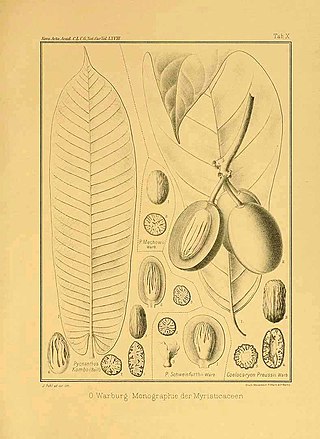
Pycnanthus angolensis is a species of tree in the nutmeg family, Myristicaceae. It is native to Tropical Africa. Its English language common names include African nutmeg, false nutmeg, boxboard, and cardboard. In Africa it is widely known as ilomba.

Trifolium angustifolium is a species of clover known by the common names narrowleaf crimson clover, narrow clover and narrow-leaved clover.
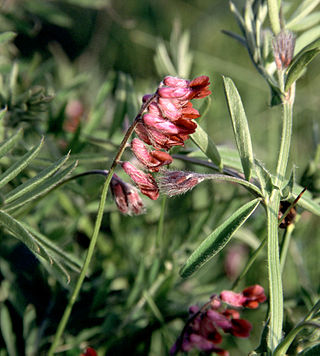
Vicia benghalensis is a species of vetch known by the common names purple vetch and reddish tufted vetch. It is native to southern Europe, North Africa, and nearby islands, and it is utilized elsewhere in agriculture and may be present in the wild as an introduced species. It is an annual herb with a climbing stem which is coated in hairs, often densely, making the plant appear silvery white. Each leaf is made up of several pairs of elongated leaflets which measure up to 3 centimeters in length. The inflorescence is a one-side raceme of several dark reddish purple flowers. Each flower has a densely hairy calyx of sepals and a tubular corolla between one and two centimeters in length. The fruit is a flat, hairy legume pod up to 3.5 centimeters long containing multiple seeds.

Asimina pulchella is a rare species of flowering plant in the custard apple family known by the common names beautiful pawpaw, royal false pawpaw, and white squirrel banana. It is a federally listed endangered species.

Hypericum cumulicola is a rare species of flowering plant in the family Hypericaceae known by the common name highlands scrub hypericum, or highlands scrub St. John's wort. It is endemic to Florida, where it is threatened by habitat loss and degradation. It is a federally listed endangered species of the United States.

Paronychia chartacea is a rare species of flowering plant in the family Caryophyllaceae known by the common names papery Whitlow-wort and paper nailwort. It is endemic to Florida in the United States. There are two subspecies of the plant; ssp. chartacea occurs in Central Florida, especially the Lake Wales Ridge, and ssp. minima is native to the Florida Panhandle. The two subspecies are geographically separated and do not occur together. Both are included on the federal Endangered Species List, on which the species is designated threatened.

Astragalus australis is a species of flowering plant in the legume family known by the common name Indian milkvetch. It is native to much of the Northern Hemisphere, including northern North America, Europe, and temperate Asia.

Parkia timoriana is a species of flowering plant in the legume family. English common names include tree bean. It is native to Thailand, Malaysia, Myanmar, Indonesia, and Assam and Manipur in India. It is widely cultivated for food and wood, and as an ornamental.

Aeschynomene indica is a species of flowering plant in the legume family. Common names include Indian jointvetch, kat sola, budda pea, curly indigo, hard sola, northern jointvetch, indische Schampflanze (German), angiquinho, maricazinho, papquinha, pinheirinho, he meng (Chinese), kusanemu (Japanese), diya siyambala (Sinhala), and ikin sihk (Pohnpeian).
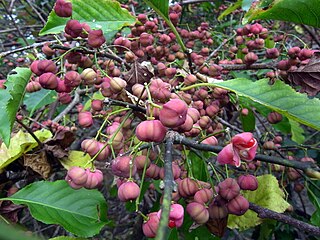
Euonymus hamiltonianus, known by the common names Hamilton's spindletree, Himalayan spindle, and Siebold's spindle is a species of flowering plant in the family Celastraceae. It is native to Asia, where it is distributed in Afghanistan, Russia, China, Japan, Korea, India, Nepal, Pakistan, Bhutan, Thailand, and Myanmar. This is one of the most common Euonymus species. It is cultivated in gardens and landscapes in other parts of the world.

Alysicarpus vaginalis is a species of flowering plant in the legume family, Fabaceae. It is native to parts of Africa and Asia, and it has been introduced to other continents, such as Australia and the Americas. It is cultivated as a fodder for livestock, for erosion control, and as a green manure. Common names include alyce clover, buffalo clover, buffalo-bur, one-leaf clover, and white moneywort.
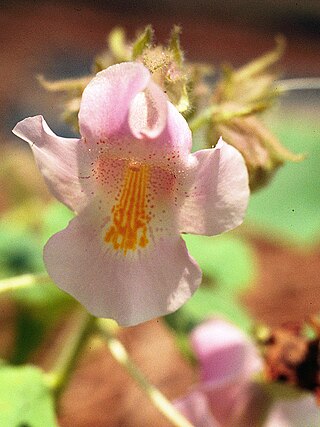
Proboscidea louisianica is a species of flowering plant in the family Martyniaceae. Its true native range is unclear, but probably includes parts of the southwestern United States and Mexico in North America. It occurs in other areas, including other regions in North America, Europe, Australia, and South Africa, as an introduced species. It is the most widely distributed species in its family. Common names it shares with other Proboscidea species include devil's claw and unicorn-plant. Names more specific to the species include common devil's claw, ram's horn, aphid trap, Louisiana unicorn-plant, purple-flowered devil's-claw, goat's head, elephant tusks, and martinoe.

Canavalia cathartica, commonly known as maunaloa in the Hawaiian language, is a species of flowering plant in the legume family, Fabaceae. The Hawaiian name translates as long mountain. In English it may also be known as poisonous sea bean, ground jack bean, horse bean, silky sea bean or wild bean. It has a Paleotropical distribution, occurring throughout tropical regions in Asia, Africa, Australia, and many Pacific Islands, and extending just into subtropical areas. It is not native to Hawaii, and is an invasive species there.
